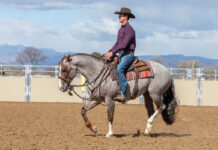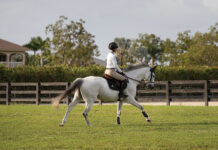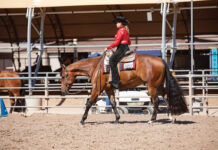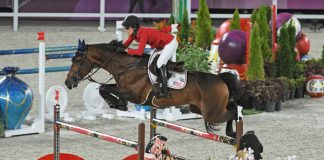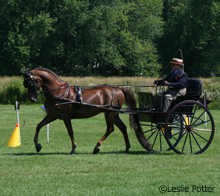 Anyone who has witnessed, or been involved in, an accident with a horse-drawn vehicle knows how horrific the consequences can be. Because most horses are hard-wired to run now, think later,you can never be absolutely certain you won’t have such an experience while driving your horse. If you’re interested in driving, you can reduce the odds of an accident by making safety your highest priority. In fact, every aspect of driving horses–the driver, horse, harness, cart, passengers, the route and other drivers–should be subject to safety scrutiny.
Anyone who has witnessed, or been involved in, an accident with a horse-drawn vehicle knows how horrific the consequences can be. Because most horses are hard-wired to run now, think later,you can never be absolutely certain you won’t have such an experience while driving your horse. If you’re interested in driving, you can reduce the odds of an accident by making safety your highest priority. In fact, every aspect of driving horses–the driver, horse, harness, cart, passengers, the route and other drivers–should be subject to safety scrutiny.
A Suitable Horse
Wes Licht, founding member of the Midwest Distance Driving Association and Dairyland Driving Club, combined driving event (CDE) competitor, and renowned driving instructor and clinician, thinks the horse and driver should be a compatible team. Matching the skills of the driver with the temperament of the horse is very important. Green horses and green drivers don’t mix.
A safe and reliable driving horse needs to be sound, fit, calm, non-spooky and tractable. The lack of any one of these characteristics can spell trouble down the road. If you are interested in buying a driving horse, be sure the seller demonstrates that the horse is well trained to harness, hitch and drive.
Proper Training
To drive and be safe when hooked to a cart, your horse must be fully trained. Assuming that any riding horse should be willing and happy to pull a cart is a fairly common mistake inexperienced and would-be drivers make. Chances are, without extensive groundwork for driving, you’ll never even make it into the seat before your horse tries to leave the scene. If you’ve never seen a frightened horse bolt with a cart attached, consider yourself lucky because it is probably the scariest situation you can face with a horse.
The key to safe driving is taking the time to completely train the horse, not only to wear the harness and pull the vehicle, but to obey the driver and tolerate obstacles he’ll encounter along the path.
Pat Fitzgerald, an instructor in Oregon, Wisc., has been training and showing champions in all disciplines, including driving, from local to national competitions since 1958. She believes in exposing her horses to everything from noisemakers to cavalletti.
“I expose my horses to everything I can think of. I have them go over PVC poles, wiggly sump pump pipe, rough ground, up and down hills, you name it,” Pat says. “I also gently teach my horses to hobble, so they learn restraint. And, before ever showing a young horse in driving classes, I take him around the grounds in long lines until he is relaxed, breathing normally and looking somewhat bored.
“My main requirement for a driving horse is that he trusts me and looks to me as the leader in any kind of emergency,” Pat continues. “This takes a lot of prep work that can’t be rushed. The biggest mistake I see drivers make with their horses is hooking them up too soon because they get in a rush to do the fun part. I’ve seen horses that were scary to lead, much less drive!”
Harness Integrity
No matter what type of harness you put on your horse–leather, nylon or Biothane (urethane-coated nylon)–it must fit, be clean and, most importantly, be strong enough to withstand the strain it is subjected to during a drive. Nylon, typically used for training harnesses, is undeniably strong but can fray. Leather, the harness of choice for most drivers, is definitely labor-intensive and must be continually cleaned, conditioned and inspected for pliability and strength. Without proper care, leather straps crack rather than loop when you bend them–a sure sign they need replacing. Even if you discover an old harness in your barn, or buy one cheaply at an antique shop, use it only for decoration; even if the leather seems to be in good shape, which is unlikely, chances are the fit is wrong.
Check your harness every time you put it on your horse, especially the straps that are most stressed when in use, such as the hame, breeching and tug straps. Occasionally, you should test driving lines by fastening the bit ends to something solid and giving them a good pull. Discovering a serious flaw at the outset of a long drive is far better than the alternative.
Wes Licht adds, “because harnessing mistakes and equipment failure often lead to accidents, it is important to know and practice the proper procedures for harnessing and unharnessing. Worn harness and vehicle parts must be replaced, or they may fail when you need them most.”
Safety in Harnessing and Unharnessing
Harness your horse in a spacious area and make sure you have control of his head at all times. You can loop a rope around your horse’s neck for control, or, better yet, use a free-head horse collar, especially when bridling. Always harness and unharness your horse in the same order so that he’ll learn the routine and won’t be surprised by your movements. Double check that all harness straps are in keepers and no tail hair is caught under the crupper. Make sure the reins are buckled on the driver’s end to prevent loss of control by inadvertently dropping one rein. Always fasten reins to the bit immediately after bridling. Pay attention to your horse’s body language; if he’s nervous and agitated, he should not be hooked to a cart until he’s regained his composure.
Unless your horse is so broke that he practically dozes while you harness and hook him, find a capable person to help you put him to the cart. Never back between shafts on the ground; rather, carefully bring the shafts up and forward to the horse. If your horse is young or inexperienced, have a third person at his head while hitching. Harness types vary, so secure your harness to the cart in the manner appropriate to its style, then check each step you took before you climb aboard. If you are new to driving and an experienced driver is nearby, ask that person to double check your procedure.
Removing the harness in a set order will help you re-assemble the harness so that it is ready for the next use.
According to expert drivers from The Carriage Association of America, “The golden rule of driving is that no passenger should be allowed in the carriage before the driver is in place and ready. Similarly, the driver should not leave his seat while passengers are still in the carriage.”
In more succinct words: The driver is always first on and last off.
Cart, Carriage, Wagon or Sleigh
No matter what type of vehicle you’re driving, inspect it prior to your outing with the same critical attention given to the harness. While they can be tempting to buy from a historical perspective, older vehicles are often fraught with problems and expensive to repair. Even the best carriage drivers in the world are leery of antique vehicles for anyone but the very experienced.
Muffy Seaton is an internationally known carriage driver, clinician, trainer and breeder of driving ponies. She is also a CDE and United States Equine Federation judge and holds the coveted British Light Harness Horse Instructor license. Muffy is a four-time National Champion and placed third at the Royal Windsor Horse Show in 1997, and, in 2005, she trained and qualified the pony who won the gold medal at the World Pony Championship in England.
Many years ago, Muffy bought an antique, two-wheeled carriage and took it out on a long drive without checking the wheels first. “I noticed on the way home that one of the wheels looked very far away all of a sudden. Thankfully, I was close to my driveway because when I got home and looked into the wheel, I found that the cotter pin used to attach the hub to the axle was not there, and the wheel had been slowly working itself off!”
One reason to buy a vehicle from a modern cart or carriage manufacturer is that it must fit the horse and, if necessary, you will have experts on hand to make modifications. (For example, you may have a large driving horse that needs custom-length shafts.) Most people who are new to the sport of driving don’t have the knowledge to judge proper fit or disrepair, so information from experts is invaluable.
Muffy believes that people interested in driving should learn from a professional carriage driving instructor and ask a lot of questions to find out what the safety issues are before ever attempting to hook a cart to a horse.
“Be certain your horse is fit, well-trained for driving, and has enough [hoof] traction to do the job you’re asking of him,” Muffy says. “Make sure he’s been exposed to the various objects you might find along the route. Your cart and harness should be in excellent repair and fit the horse perfectly; if you’re not sure how to judge, ask a professional. Always stick to a routine in harnessing that includes constant safety checks, and go over your harness and carriage every time you hook up.”
It is an understatement to say that Muffy strongly supports wearing approved equestrian safety helmets while driving. “No one at my barn gets in a carriage without one, period. Also, carry a cell phone on your body or, at the very least, tell someone when you are leaving, where you are going and when you plan to get back. If you can, take someone along with you. Carriage driving is a more dangerous sport than many people realize because, in an accident, it’s much harder to vault out of a carriage than from a horse. Most importantly, stay alert to potential threats to your horse and deal with them before they become an issue.”
Any activity involving horses carries a certain amount of risk, but you can reduce those risks significantly through proper training and safe driving practices. As Muffy says, “Do your homework, take care of your equipment and your horse, wear a hard hat and happy safe driving!”
Learn more about driving expert Muffy Seaton here.

